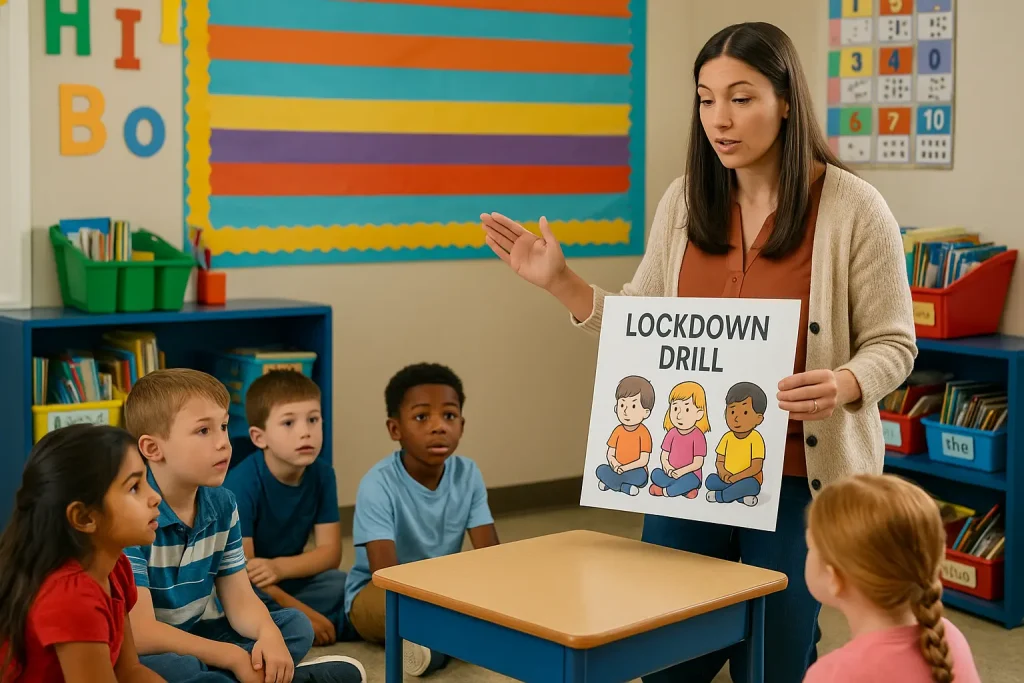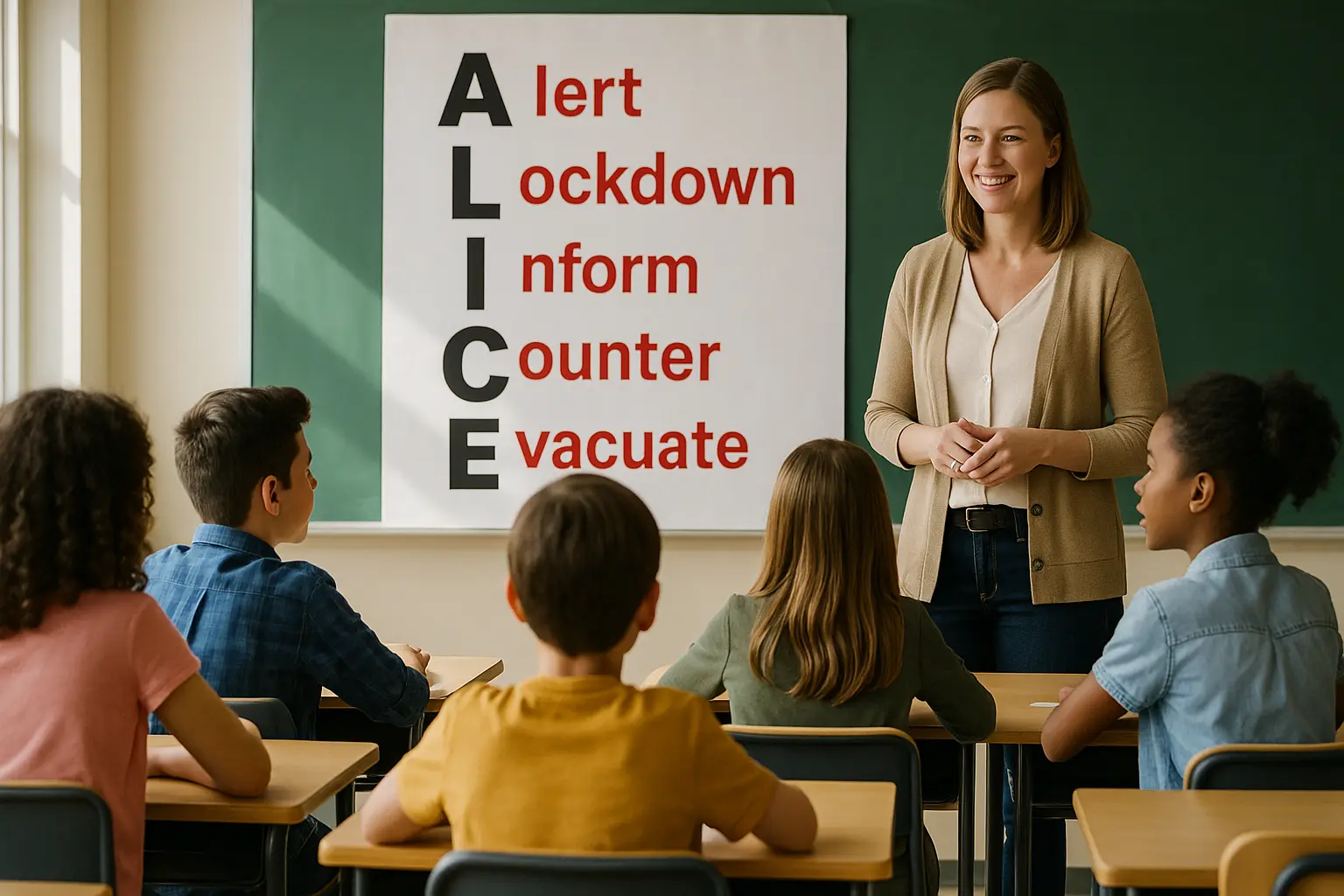For the last 20 years, ALICE Training has helped schools be better prepared for an active shooter situation by providing strategies designed to save lives during a crisis. With gun violence at schools at an all-time high, this type of proactive training has become a vital part of a school’s overall security plan and infrastructure. This article explains what ALICE training is and how it can help schools be better prepared for active shooters in the future.
Key Takeaways
- ALICE Training empowers students and staff with proactive strategies for responding to active shooter situations, moving beyond traditional lockdown protocols.
- The program consists of five core components: Alert, Lockdown, Inform, Counter and Evacuate. The combination of these strategies is designed to enhance overall emergency response capabilities in schools.
- ALICE Training emphasizes a trauma-informed approach and tailored instruction to accommodate varying developmental levels, ensuring comprehensive understanding and preparedness for both students and staff.
- How technology innovations in AI can benefit and enhance the ALICE system, specifically in Alerting and Informing with AI Gun Detection, automated notification, and emergency response.
What is ALICE Training?

ALICE Training was the first civilian active shooter response training program designed to teach students and staff how to respond to active shooter situations proactively, rather than just reacting to lockdown protocols. Developed by experts from multiple fields, the program provides comprehensive emergency response strategies that train individuals on the best and safest ways to act during an armed intruder incident. This training also includes participation by local police since they are often the first ones called when an active shooter comes onto a school campus. A strong partnership between the police and the school district is key to developing effective safety plans to handle crisis situations.
Today, ALICE Training has more than 18,000 certified instructors, and thousands of organizations have been trained nationwide. The program features a multi-option-based response model that allows as many people as possible to choose the best option during an emergency to increase their chances of survival. These response options are situation-dependent and adaptable to each emergency. The proactive nature of the program encourages active assessment and response, which has made ALICE Training a critical component of modern school security.
Core Components of ALICE Training
The heart of ALICE Training consists of 5 key components:
- Alert
- Lockdown
- Inform
- Counter
- Evacuate
Each component is designed to help individuals recognize and respond to a threat so they have a comprehensive and adaptable response plan that guides them on what to do during an active shooter situation.
Implementing these components is key to enhancing a school’s emergency response plan and can very likely be the difference between whether lives are lost or saved during an active shooter situation.
Alert

Recognizing danger quickly is key to survival and can help ensure better decision-making in an active shooter situation. This requires both students and staff to be aware of their surroundings and be ready to identify unusual behavior that may help detect threats sooner. When a staff member recognizes danger, for example, they can immediately send out an alert so potential threats are communicated as soon as possible. This awareness and recognition allow individuals to react quickly and correctly to increase the chances of a successful response.
In an emergency, every second counts. That is why the Alert component or emergency notification systems are so important. This ensures that threats are communicated quickly, which then allows an immediate action to help diffuse the situation as rapidly as possible.
Lockdown
The Lockdown techniques in ALICE Training are important for keeping individuals safe during active shooter situations. Unlike traditional methods, this strategy teaches students and staff to understand door mechanisms and the importance of a locked door during the school day. This component also covers what can be used to help barricade a door if needed during a situation.
Knowing how to create barriers and secure a classroom is critical for keeping individuals safe until law enforcement arrives.
Inform

Real-time information is key in any emergency. The Inform component of ALICE outlines ways that those involved can provide timely updates on the shooter’s location and movement, so first responders can better respond.
During any active shooter situation, knowing where the shooter is located allows first responders or staff to make accurate and informed decisions, such as to evacuate or lock down. Making the right decision at this time can save lives by ensuring students and staff stay away from harm’s way.
Counter
The Counter technique in ALICE Training outlines ways students, staff and law enforcement can distract and disorient the shooter to buy time for individuals to escape. This counter strategy can include making noise or using whatever is available to disrupt the intruder’s focus and movement. It is important to note, however, that countering is not the same as fighting, and fighting should only be considered as a last resort when all else fails.
Creating a distraction with the Counter technique buys valuable time that students and staff need to evacuate or get to a safer location that can reduce their risk of being harmed.
Evacuate
The Evacuation component in ALICE Training is considered the safest option when time and distance allow. The training stresses the importance of knowing exit locations so that if it is safe to evacuate, students and staff can quickly leave the building or campus. Recognizing and getting out of the danger zone in an emergency is the most effective way to reduce risk.
This emphasis on evacuation aligns with the broader “Run, Hide, Fight” guidance promoted by the Department of Homeland Security and the FBI—encouraging individuals to run (evacuate) when it is safe to do so, hide or barricade if escape is not possible, and only fight (counter) as a last resort when directly confronted.
After evacuating, it’s important for students and staff to go to their designated rally points, which should have been practiced in routine training. These locations define safe places to gather and ensure that everyone is accounted for after a crisis. Acting fast in any emergency situation can be the difference between life and death. Prioritizing evacuation when possible gets people out of danger and greatly increases their chances of survival.
School Specific Training

ALICE Training is not a one-size-fits-all solution. It is designed to meet the developmental and cognitive levels of all participants, including young students and those with special needs. Everyone should receive age-specific training to ensure they understand how to act in an emergency. Tailored training can also minimize anxiety and ensure the program works for all students, regardless of age or developmental level.
A key part of ALICE Training is the availability of lesson plans and visual aids that help teachers deliver age-appropriate content so students of all ages can understand the safety strategies being outlined.
The program also acknowledges the emotional impact an active shooter can have on campus, and it is designed to create a safe learning environment. This helps students feel safer and more confident in their emergency response during an active shooter situation.
Blended Learning Approach
ALICE Training offers a blended learning approach that combines online learning with in-person practice, both of which are designed to help schools and organizations have a prepared response to an active shooter incident. Students and staff have an on-demand lesson library available for the online component, and this includes training that can be tailored to individual and organizational needs.
By combining different learning methods, ALICE Training helps students and staff retain important information and builds confidence that they are well prepared to respond to a threat.
Trauma-Informed Practices
ALICE Training is trauma-informed, which is critical as trauma is prevalent in schools today. The program helps create a physically and emotionally safe environment for students during safety training. For example, it’s important to provide advance notice before active shooter safety drills to help students, staff and parents prepare mentally. This can help reduce potential trauma. Trauma-informed training also uses less dramatic simulations to minimize stress.
As part of the training, it’s important for instructors to initiate post-drill discussions to allow students to process their experience and feelings. This helps to reduce anxiety and should include the use of respectful language while also avoiding any triggers that might make students and staff feel less safe.
Instructor Certification Programs
The ALICE Certified Instructor class helps communities become safer by training teachers and others on how to respond to active shooter threats. This two-day certification process includes options for private classes and other customized material needed to meet the organization’s goals.
By having a large number of ALICE Certified Instructors across the school district, educational institutions can maintain a high level of preparedness.
Compliance and Preparedness
ALICE Training also helps schools comply with safety regulations issued by local, state and federal regulations for emergency response training. By training employees and having an active shooter policy, schools can ensure they are prepared and ready for emergencies.
By holding regular scenario-based drills and monthly reviews of ALICE Training concepts, schools can increase their understanding and integration of safety protocols among students and staff. This proactive safety culture enables organizations to shift from a reactive to a proactive and prepared approach.
Community and Organizational Support

ALICE Training works with organizations across all sectors to customize safety plans to fit their needs. By incorporating ALICE Training into their schools, districts have changed their approach to school safety and created a culture of readiness and resilience. Certified ALICE Training instructors can tailor the training to fit an organization’s needs so they have the most relevant and effective safety and response plan in the event an active shooter comes onto their campus.
AI Innovations Enhancing ALICE Training: AI Gun Detection
ALICE Training has a 20-year legacy of helping organizations prepare for active shooters and other threats. Over time, the program has evolved to include the availability of innovative new technologies, providing schools with even more layers of security to help protect their students and staff. A perfect example is the emergence of AI and products such as visual AI gun detection. Use of AI technologies can be easily integrated into school safety protocols to complement and enhance ALICE Training.
One of the most widely used visual AI gun detection systems today is Omnilert Gun Detect. This was developed by Omnilert, a company with more than 20 years of experience developing life-saving solutions designed to help save lives from gun violence. Omnilert’s Gun detection system can detect a gun in a fraction of a second— and once the detection is human-verified, it’s the only platform capable of launching a full-scale, real-time emergency response across an entire facility. This could include dispatching law enforcement, initiating lockdowns, starting alarms and digital signage and sending mass communications with location-specific and incident details.
Omnilert also enables two-way interaction during an emergency—empowering organizations to communicate directly with their people, including staff, students and citizens, to manage the situation as it unfolds. It can also provide detailed situational intelligence throughout the event so that first responders know exactly where to go, who to look for, and what type of threat they face—ensuring a faster, more effective response.
Omnilert Gun Detect can be used with existing IP-based cameras already installed inside a school or outside a building. By integrating this technology with ALICE Training protocols, schools can benefit from a more comprehensive emergency response plan. The early detection and instant alerts provided by Omnilert Gun Detect can allow for quicker activation of the ALICE Training components—Alert, Lockdown, Inform, Counter and Evacuate. This will enable staff and students to respond faster and with more situational awareness. For example, timely alerts can initiate lockdowns or evacuations sooner, and accurate information about the intruder’s location can help with countermeasures or escape routes.
Another advantage of visual AI gun detection is that it reduces reliance on human monitors, minimizing response delays caused by uncertainty, missed visual cues or distraction. This extra layer of protection allows schools to implement ALICE Training with more confidence and precision. It also maximizes the benefits of ALICE Training by providing faster, more accurate threat recognition and proactive, life-saving responses during an active shooter situation.
Testimonials and Success Stories
Schools that have implemented ALICE Training have reported more confident and prepared staff and students when responding to emergencies. For example, Charlie Morse, Safety & Security Director for Walton County School District in Florida, says ALICE Training is part of their safety protocols and calls it “the fabric of our safety“.
These testimonials and success stories show the real-world impact of ALICE Training and how it creates safer schools by empowering individuals to respond better during emergencies.
Layers of Protection are Key for the Future
ALICE Training is a comprehensive proactive approach to school safety. By understanding and implementing the core components, schools can create a safer environment for students and staff. The customized training, blended learning and trauma-informed practices help it meet the needs of all participants, regardless of age or developmental status.
Because no one technology or strategy can stop gun violence in American schools, it’s important for districts to embrace a layered approach to school safety. This may include ALICE Training as well as visual AI gun detection, metal detectors or added school resource officers. Working together, these layers can provide a more comprehensive and successful approach to school safety.
Frequently Asked Questions (FAQs)
What does ALICE stand for?
ALICE stands for Alert, Lockdown, Inform, Counter and Evacuate. Knowing these core components can help keep schools safer and better prepared in a crisis.
How is ALICE Training adapted for different age groups?
ALICE Training is adapted for different age groups by using age-appropriate lesson plans and visual aids that match the developmental and cognitive levels of the participants, including young students and individuals with special needs. This tailored approach ensures that the training concepts in ALICE are understood by all those who might be impacted during an active shooter incident.
What is the importance of the Counter component in ALICE Training?
The Counter component is key in ALICE Training as it teaches students and staff to create distractions to disorient an intruder so they can escape or find a safer place to hide. This approach prioritizes disruption over direct confrontation and keeps people safer in a crisis.
How does ALICE Training support compliance with safety standards?
ALICE Training supports compliance with safety standards by aligning with local, state and federal emergency response requirements and ensuring that regular drills and reviews are conducted to ensure the highest level of preparedness. This structured approach helps schools meet their safety protocols.
Is there virtual training for ALICE Training?
Yes, ALICE Training has virtual training on their website, and these can be customized to meet the needs of any particular school or organization.



